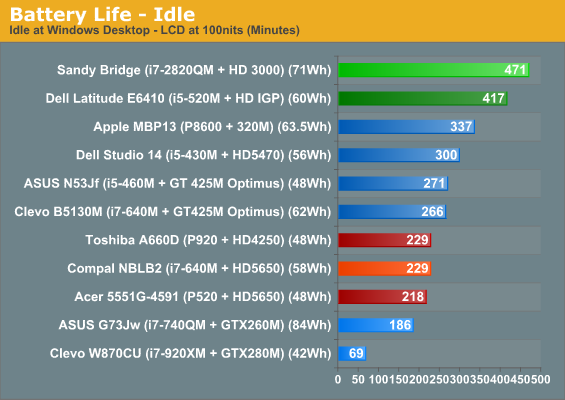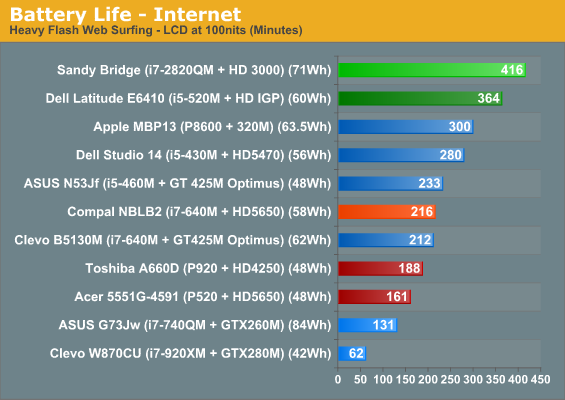Intel’s Sandy Bridge i7-2820QM: Upheaval in the Mobile Landscape
by Jarred Walton on January 3, 2011 12:00 AM EST- Posted in
- Laptops
- Intel
- Sandy Bridge
- Compal
All the Performance, and Good Battery Life As Well!
We’ve just finished showing that CPU and GPU performance has basically more than doubled compared to last year’s Arrandale offerings. That’s great news, but what happens to battery life? We’ve got 35W TDP Arrandale parts compared to a 45W TDP Sandy Bridge quad-core; doesn’t that mean battery life will decrease by around 25%? The answer is happily no; as we’ve point out in the past, TDP isn’t really a useful measurement of power requirements. All the TDP represents in this case is the maximum amount of power Sandy Bridge should draw. So worst-case battery life under full load might drop, but the real question is going to be what happens under typical workloads.
Intel’s use of power gating and variable clock speeds is put to good use, with the result being battery life that is nothing short of exceptional when compared to previous generation products. We’ve seen ULV and Atom netbooks and ultraportables get battery life into the 8+ hour range, but such designs have always required serious compromise in the performance department. SNB certainly won’t beat out Atom for pure battery life, but that doesn’t mean it’s a power hog. Our Compal test system comes with a 71Wh battery, which is larger than what we’ve seen in many 15.6” and smaller designs but still reasonable for a 17.3” chassis. Here are the results of our standard battery life testing.




Yes, those figures are accurate. Best-case, running at 100nits, quad-core Sandy Bridge still lasted nearly eight hours on a single charge! What’s more interesting is that our standard Internet battery life test that loads four pages with Flash ads every sixty seconds still checks in just shy of seven hours. Finally, H.264 playback also comes in at the top of our charts, providing more than four hours of demanding video playback. If 240 minutes of content off your HDD/SSD isn’t enough, we also were able to watch a Blu-ray disc and still get 220 minutes of 35Mbit VLC playback. Wow!
So Sandy Bridge comes out on the top of the above charts, but we didn’t include some of the other long battery life alternatives. Just to put things in perspective, ASUS’ U30JC—with an SSD and an 84Wh battery—has long been our king for matching reasonable performance with long battery life. It managed 588 minutes idle, 476 minutes Internet, and 254 minutes H.264 playback. That’s 25% more idle life, but only 14% better Internet and actually slightly lower H.264 battery life, and you need to factor in the 18% higher capacity battery and 13.3” (versus 17.3”) LCD.
We have to wonder just how small of a form factor manufacturers can manage to cram the quad-core Sandy Bridge into. Idle and low usage power requirements are clearly very good, but with maximum TDP still at 45W the chassis needs to be able to handle the heat. We’d really love to see some 14” designs with quad-core CPUs, and the icing on the cake would be sticking a reasonably fast discrete GPU with graphics switching technology into the case as well. Intel doesn’t have any LV/ULV quad-core parts listed—yet!—so we may have to wait for ultraportable quad-core laptops, but certainly 15.6” designs should be able to combine SNB with reasonably fast Optimus GPUs to provide an optimal blend of performance and mobility.










66 Comments
View All Comments
JarredWalton - Tuesday, January 4, 2011 - link
Definitely a driver bug, and I've passed it along to Intel. The HD 4250 manages 7.7FPS, so SNB ought to be able to get at least 15FPS or so. The game is still a beast, though... some would say poorly written, probably, but I just call it "demanding". LOLsemo - Monday, January 3, 2011 - link
Thanks for mentioning USB 3.0 Jarred. It is a much too overlooked essential feature these days. I simply will not pay money for a new laptop in 2011 without a single USB 3.0 port.dmbfeg2 - Monday, January 3, 2011 - link
Which tool do you use to check the turbo frequencies under load?JarredWalton - Monday, January 3, 2011 - link
I had both CPU-Z and the Intel Turbo Monitoring tool up, but neither one supports logging so I have to just eyeball it. The clocks in CPU-Z were generally steady, though it's possible that they would bump up for a few milliseconds and then back down and it simply didn't show up.Shadowmaster625 - Monday, January 3, 2011 - link
On the other Sandy Bridge article by Anand, right on the front page, it is mentioned that the 6EU GT1 (HD2000) die has 504M transistors, while the 12EU GT2 (HD 3000) die has 624M transistors. Yet here you are saying HD Graphics 3000 has 114M. If the 12EU version has 120M more transistors than the 6EU version, then does that not imply a total gpu transistor count well north of 200M?JarredWalton - Monday, January 3, 2011 - link
AFAIK, the 114M figure is for the 12EU core. All of the currently shipping SNB chips are quad-core with the full 12EU on the die, but on certain desktop models Intel disables half the EUs. However, if memory serves there are actually three SNB die coming out. At the top is the full quad-core chip. Whether you have 6EU or 12EU, the die is the same. For the dual-core parts, however, there are two chips. One is a dual-core with 4MB L3 cache and 12EUs, which will also ship in chips where the L3 only shows 3MB. This is the GT1 variant. The other dual-core version is for the ultra-low-cost Pentium brand, which will ship with 6EUs (there will only be 6EU on the die) and no L3 cache, as well as some other missing features (Quick Sync for sure). That's the GT2, and so the missing 120M includes a lot of items.Note: I might not be 100% correct on this, so I'm going to email Anand and our Intel contact for verification.
mino - Monday, January 3, 2011 - link
Nice summary (why was this not in the article ?).Anyway those 114M do not include memory controller, encoding, display output etc. so the comparison with Redwood/Cedar is not really meaningful.
If you actually insist on comparing transistor counts, semething like (Cedar-Redwood)/3 shall give you a reasonable value of AMD's SPU efficiency from transistors/performance POW.
mino - Monday, January 3, 2011 - link
"After all, being able to run a game at all is the first consideration; making it look good is merely the icing on the cake."If making it look good is merely icing on the cake, why bother with GPUs ? Lets just play 2D Mines!
(While for the poor souls stuck with Intel IGPs it certainly is just the icing, for Christ's sake, that is a major _problem_, not a feature !!!)
After a few pages I have decided to forgo the "best-thing-since-sliced-bread" attitude, but, what is too much is too much...
mino - Monday, January 3, 2011 - link
Regardless the attitude, HUGE thanks for listening to comments and including the older games roundup.While I'd love to see more games that actually provide playable frame-rates (read: even older ones) on SNB-class IGPs like Far Cry or HL2, even this mini-roundup is a really big plus.
As for a suggestion on future game-playability roundup on IGP's, it is really simple:
1) Take a look at your 2006-2007 GPU benchmarking suites
2) Add in a few current MMORPGs
JarredWalton - Monday, January 3, 2011 - link
Anand covered several other titles, and most of the pre-2007 stuff should run fine (outside of blacklisting problems or bugs). Time constraints limit how much we can test, obviously, but your "reviewer on crack" comment is appreciated. 2D and 3D are completely different, and while you might feel graphical quality is of paramount importance, the fact of the matter is that SNB graphics are basically at the same level as PS3/Xbox 360 -- something millions of users are "okay" with.NVIDIA and AMD like to show performance at settings where they're barely playable and SNB fails, but that's no better. If "High + 1680x1050" runs at 20FPS with Sandy Bridge vs. 40FPS on discrete mobile GPUs, wouldn't you consider turning down the detail to get performance up? I know I would, and it's the same reason I almost never enable anti-aliasing on laptops: they can't handle it. But if that's what you require, by all means go out and buy more expensive laptops; we certainly don't recommend SNB graphics as the solution for everyone.
Honestly, until AMD gets the Radeon equivalent of Optimus for their GPUs (meaning, AMD GPU + Intel CPU with IGP and automatic switching, plus the ability to update your Radeon and Intel drivers independently), Sandy Bridge + GeForce 400M/500M Optimus is going to be the way to go.